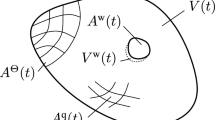Abstract
The paper presents the results of our recent developments. Studies for detailed understanding of the behaviour of a steel structure during welding operations have been carried out. Mainly the distortion of the steel structure has been observed. Several welding experiments have been prepared and carried out. The results from the welding experiments have been used as the input and output parameters during the numerical simulations. Measurements were also carried out on the material properties needed for numerical analysis. Numerical simulations have been made according to experiments. The calculated results were compared with the measured results. Based on the comparison parameters have been determined, which have an influence on the final distortion of the steel structure. The following input parameters have been observed: model of the temperature source, constraint condition, and material models. A good correlation has been obtained for temperature (mainly for shape and size of the molten zone) as well as distortion prediction between experimental and numerical approaches. The double ellipsoid heat source model has been used and modified to fit the measured parameters. The modified double ellipsoid heat source was used for MMAW and GTAW welding technology.
Similar content being viewed by others
References
ESI Group: SYSWELD reference manual, Digital form SYSWELD version 2004.1.
Kou S.: Welding metallurgy, University of the Wisconsin, a Wiley-Interscience publication, August 1987.
Hrivňák I., Štembera V., Mráz L’., Király F.: Diagramy rozpadu austenitu vývojových čs.konstrukčných ocelí a zvarových kovov, Výyzkumný ústav zváračský, leden 1980.
Goldak J., Bibby M., Moore J., House R., Patel B.: Computer modeling of heat flow in welds, Metallurgical transaction B, Volume 17 B, September 1986.
Goldak J., Chakravarti A., Bibby M.: A new finite element model for welding heat source, Metallurgical transactions B, Volume 15 B, June 1994.
Dong P.: Residual stresses and distortion in welded structures: What we know today and beyond, IIW/IIS Doc.XII-X/XIII/XV-RSDP-89–03, Based on keynote lecture presented at the 6th International conference of trends in welding research, April 15–16, 2002, Pine Mountain, Georgia, USA.
Diviš V., Slováček M., Ochodek V., Floryan J.: Evaluation of welding distortion of VV polodial segmant, validation of method, experiments, Zpráva ÚAM Brno 3616/04, Brno, October 2004.
Slováček M., Diviš V.: Evaluation of welding distortion of VV polodial segmant, validation of method, Zpráva ÚAM Brno, Brno 3586/04, October 2004.
Slováček M., Diviš V.: Technická podpora v oblasti svařování, Workshop “Svařování konstrukcí” (welding of the constructions), Czech Welding Society, February 2005.
Author information
Authors and Affiliations
Rights and permissions
About this article
Cite this article
Slováček, M., Diviš, V., Junek, L. et al. Numerical Simulation of the Welding Process — Distortion and Residual Stress Prediction, Heat Source Model Determination. Weld World 49, 15–29 (2005). https://doi.org/10.1007/BF03266499
Published:
Issue Date:
DOI: https://doi.org/10.1007/BF03266499




